Themed collection Polymer Chemistry Emerging Investigators

Emerging investigators 2020
This themed issue of Polymer Chemistry highlights the work of emerging investigators in Polymer Chemistry. Editor-in-Chief Christopher Barner-Kowollik introduces the issue.

Polym. Chem., 2020,11, 153-165
https://doi.org/10.1039/C9PY90185J
Recent advances in RAFT polymerization of monomers derived from renewable resources
In this Minireview, RAFT polymerization of monomers derived from renewable resources is explored. Methods used to prepare these monomers are discussed, and potential applications of the resulting renewable polymers are highlighted.
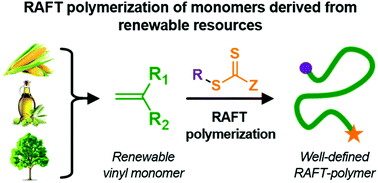
Polym. Chem., 2020,11, 220-229
https://doi.org/10.1039/C9PY01128E
Hydrogel scaffolds for tissue engineering: the importance of polymer choice
We explore the design and synthesis of hydrogel scaffolds for tissue engineering from the perspective of the underlying polymer chemistry. The key polymers, properties and architectures used, and their effect on tissue growth are discussed.
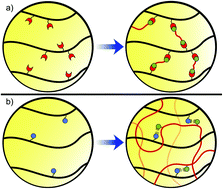
Polym. Chem., 2020,11, 184-219
https://doi.org/10.1039/C9PY01021A
Tuning chromatic response, sensitivity, and specificity of polydiacetylene-based sensors
In this review, we provide an overview of six major techniques to tune the sensitivity and specificity of polydiacetylene-based sensors.
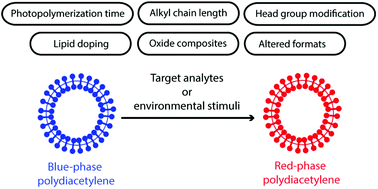
Polym. Chem., 2020,11, 166-183
https://doi.org/10.1039/C9PY00949C
Tunable swelling and deswelling of temperature- and light-responsive graphene oxide-poly(N-isopropylacrylamide) composite hydrogels
Swelling and deswelling behaviors of graphene oxide-poly(N-isopropylacrylamide) composite hydrogels can be tuned by the concentrations of a chemical crosslinker and graphene oxide, and the rate of the external temperature change.
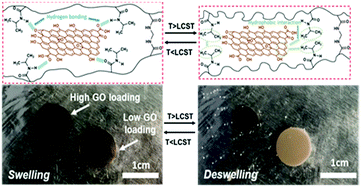
Polym. Chem., 2020,11, 2332-2338
https://doi.org/10.1039/C9PY01934K
Thermo-responsive 3D-printed polyrotaxane monolith
Thermo-responsive 3D-printed hydrogels that are composed of methylated α-cyclodextrin polyrotaxanes have been synthesized through post-3D-printing methylation.
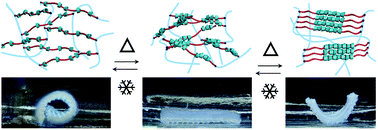
Polym. Chem., 2020,11, 304-308
https://doi.org/10.1039/C9PY01510H
Functionalization-induced self-assembly under ambient conditions via thiol-epoxide “click” chemistry
Polymer micelles were formed using thiol-epoxide “click” chemistry to trigger functionalization-induced self-assembly (FISA) of block copolymers by modifying a reactive glycidyl methacrylate block with solvophobes.
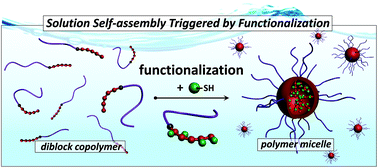
Polym. Chem., 2020,11, 298-303
https://doi.org/10.1039/C9PY01144G
Forcing single-chain nanoparticle collapse through hydrophobic solvent interactions in comb copolymers
We demonstrate that we can tune the chain collapse of comb copolymers into single-chain nanoparticles upon UV irradiation through solvency control.

Polym. Chem., 2020,11, 292-297
https://doi.org/10.1039/C9PY01235D
The unrevealed potential of elemental sulfur for the synthesis of high sulfur content bio-based aliphatic polyesters
We introduce a novel sulfur-containing polyester derivative based on a renewable monomer bearing secondary disulfide groups. Base-mediated sulfur exchange reaction of disulfide bonds using S8 delivers polyesters with tailored functional properties.
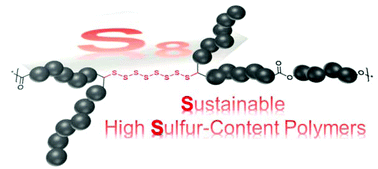
Polym. Chem., 2020,11, 241-248
https://doi.org/10.1039/C9PY01152H
Polyelectrolyte hydrogel capsules as stabilizers for reconfigurable complex emulsions
Polyelectrolyte capsules stabilize biphasic oil droplets while preserving droplet reconfigurability in the presence of surfactants.
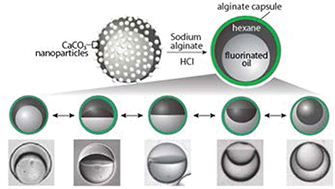
Polym. Chem., 2020,11, 281-286
https://doi.org/10.1039/C9PY00956F
Synthesis and visualization of molecular brush-on-brush based hierarchically branched structures
An atom transfer radical polymerization-mediated sequential “graft-from” approach was developed to synthesize molecular brush-on-brush (MBoB)-based hierarchically branched polymers with readily tunable structural parameters.
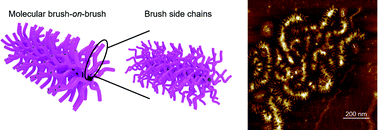
Polym. Chem., 2020,11, 270-274
https://doi.org/10.1039/C9PY01075K
Investigating the self-assembly and shape transformation of poly(ethylene glycol)-b-poly(D,L-lactide) (PEG-PDLLA) polymersomes by tailoring solvent-polymer interactions
Different ratios between THF and dioxane were used to study the effect of organic solvent composition on the self-assembly and subsequent shape-change of poly(ethylene glycol)-b-poly(D,L-lactide) (PEG-PDLLA) polymersomes.
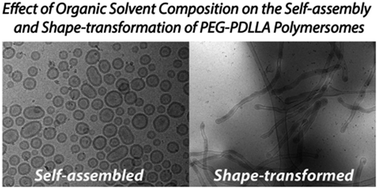
Polym. Chem., 2020,11, 275-280
https://doi.org/10.1039/C9PY01089K
Recoverable and recyclable nickel–cobalt magnetic alloy nanoparticle catalyzed reversible deactivation radical polymerization of methyl methacrylate at 25 °C
Recyclable Ni–Co alloy catalyzed synthesis of well-defined poly(methyl methacrylate) (PMMA, up to 129 500 g mol−1) with narrow-dispersity (Đ = 1.30) via a reversible deactivation radical polymerization technique is reported.
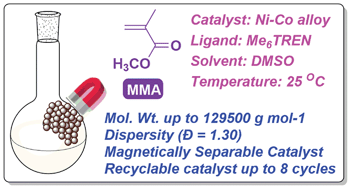
Polym. Chem., 2020,11, 287-291
https://doi.org/10.1039/C9PY00942F
Arm-degradable star polymers with crosslinked ladder-motif cores as a route to soluble microporous nanoparticles
Star polymers were synthesized via cores crosslinking of (macro)molecular ladder motifs and converted to microporous polymer particles after arm degradation.

Polym. Chem., 2020,11, 265-269
https://doi.org/10.1039/C9PY01060B
Probing the morphology evolution of chemically anisotropic colloids prepared by homopolymerization- and copolymerization-induced phase separation
Chemically anisotropic colloids prepared by polymerization-induced phase separation during seeded emulsion polymerization with non-crosslinked seeds reveals tunability in both surface and interior properties based on the morphology evolution.
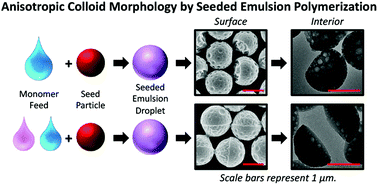
Polym. Chem., 2020,11, 230-235
https://doi.org/10.1039/C9PY01166H
Switching of the conformational flexibility of a diazacyclooctane-containing ladder polymer by coordination and elimination of a Lewis acid
We report the first system of ladder polymers capable of interconversion between rigid and flexible conformations by coordination and elimination of a Lewis acid (BPh2Cl) on diazacyclooctane units in the main chain.
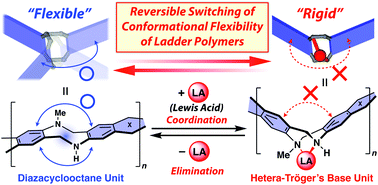
Polym. Chem., 2020,11, 236-240
https://doi.org/10.1039/C9PY01104H
Pulsed-addition ring-opening metathesis polymerization with functional enyne reagents
Functional enyne reagents enable the synthesis of low dispersity heterotelechelic polymers using catalytic quantities of ruthenium initiator.
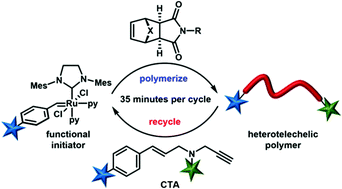
Polym. Chem., 2020,11, 259-264
https://doi.org/10.1039/C9PY00965E
A fluorescent platinum(II) metallacycle-cored supramolecular network formed by dynamic covalent bonds and its application in halogen ions and picric acid detection
A fluorescent supramolecular network for halogen ions and picric acid detection was prepared by linking metallacycles using dynamic covalent bonds.
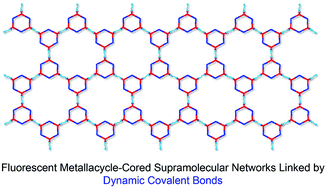
Polym. Chem., 2020,11, 254-258
https://doi.org/10.1039/C9PY00895K
Bio-inspired immobilization of low-fouling phospholipid polymers via a simple dipping process: a comparative study of phenol, catechol and gallol as tethering groups
Low-fouling phospholipid polymer was conjugated with bio-inspired tethering groups. Immobilization efficiencies of these polymers onto various surfaces were investigated.

Polym. Chem., 2020,11, 249-253
https://doi.org/10.1039/C9PY00625G
Amphiphilic poly(esteracetal)s as dual pH- and enzyme-responsive micellar immunodrug delivery systems
Amphiphilic poly(esteracetal) micelles encapsulate potent immune modulatory drugs, but fall apart and release them upon dual pH or enzymatic stimuli.
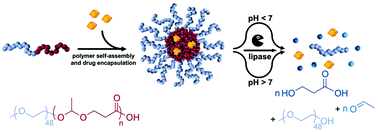
Polym. Chem., 2020,11, 2441-2456
https://doi.org/10.1039/C9PY01716J
Effects of solvents, additives, and π-allyl ligand structures on the polymerization behavior of diazoacetates initiated by π-allylPd complexes
We have revealed that the quality of control of the polymerization was improved by adding some compounds and polymer tacticity was dependent on the structures of π-allyl ligands.
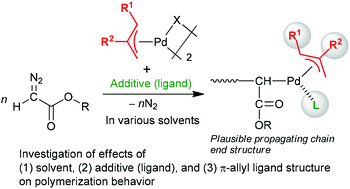
Polym. Chem., 2020,11, 1774-1784
https://doi.org/10.1039/C9PY01654F
PET-RAFT polymerization catalyzed by cadmium selenide quantum dots (QDs): Grafting-from QDs photocatalysts to make polymer nanocomposites
We report herein the first example of light-controlled radical reversible addition–fragmentation chain transfer polymerization facilitated by cadmium selenide quantum dots and the grafting-from CdSe QDs to create polymer-QDs nanocomposites.
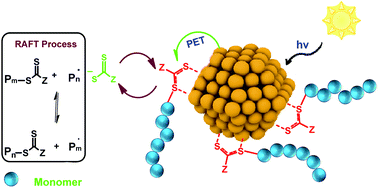
Polym. Chem., 2020,11, 1018-1024
https://doi.org/10.1039/C9PY01604J
Functionalization of NaGdF4 nanoparticles with a dibromomaleimide-terminated polymer for MR/optical imaging of thrombosis
A thrombosis-targeted molecular imaging probe with magnetic resonance (MR) and optical dual-modality capacity using dibromomaleimide (DBM)-bearing polymer-grafted NaGdF4 nanoparticles.
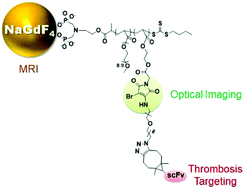
Polym. Chem., 2020,11, 1010-1017
https://doi.org/10.1039/C9PY01568J
Making the best of it: nitroxide-mediated polymerization of methacrylates via the copolymerization approach with functional styrenics
The addition of 5 mol% of functional styrenics imparts control to the SG1-mediated polymerization of methacrylates and provides access to nanostructured functional methacrylic materials.
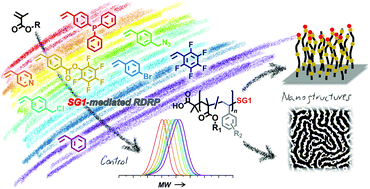
Polym. Chem., 2020,11, 593-604
https://doi.org/10.1039/C9PY01458F
Preparation of metallosupramolecular single-chain polymeric nanoparticles and their characterization by Taylor dispersion
Polymers with pendant ligands furnish single-chain polymeric nanoparticles upon intramolecular metal–ligand complex formation with different metal-ions and Taylor dispersion analysis is employed to reliably characterize the dispersed particles.
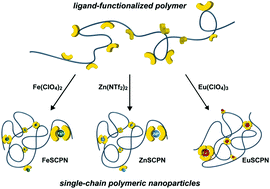
Polym. Chem., 2020,11, 586-592
https://doi.org/10.1039/C9PY01264H
A novel low-bandgap pyridazine thiadiazole-based conjugated polymer with deep molecular orbital levels
A pyridazine thiadiazole acceptor (PzT) has been utilised in the synthesis of a novel low band-gap D–A copolymer PTTPz.

Polym. Chem., 2020,11, 581-585
https://doi.org/10.1039/C9PY01137D
Facile terminal functionalization of peptides by protease-catalyzed chemoenzymatic polymerization toward synthesis of polymeric architectures consisting of peptides
Terminal functionalized polypeptides were synthesized in one-pot chemoenzymatic polymerization using protease for constructing special polymeric architectures.

Polym. Chem., 2020,11, 560-567
https://doi.org/10.1039/C9PY01335K
Degradation profiles of poly(ethylene glycol)diacrylate (PEGDA)-based hydrogel nanoparticles
PEGDA-based nanogels have been used in numerous applications, but their degradation rates have not been explored. We determine the degradation rates for multiple formulations and demonstrate key differences in degradation rates relative to bulk gels.
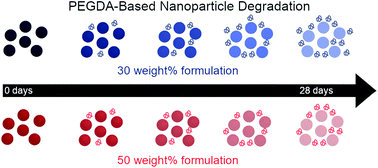
Polym. Chem., 2020,11, 568-580
https://doi.org/10.1039/C9PY01206K
Predicting the orientation of magnetic microgel rods for soft anisotropic biomimetic hydrogels
Predicting the orientation rate of rod-shaped magnetic microgels to induce unidirectional regeneration of complex and sensitive tissues.
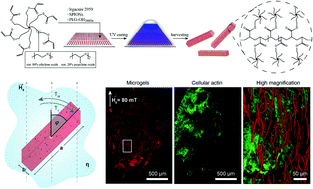
Polym. Chem., 2020,11, 496-507
https://doi.org/10.1039/C9PY01008D
Conjugated electrochromic polymers with amide-containing side chains enabling aqueous electrolyte compatibility
This work illustrates an effective side-chain modification approach using amide functional groups to induce aqueous electroactivity to ProDOT-based electrochromic polymers.
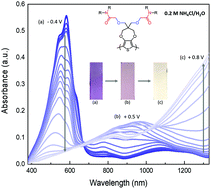
Polym. Chem., 2020,11, 508-516
https://doi.org/10.1039/C9PY01066A
pH-Responsive protein nanoparticles via conjugation of degradable PEG to the surface of cytochrome c
A protein nanoparticle system based on cytochrome c was modified with acid-degradable polyethylene glycol (PEGylation). Vinyl ether moieties distributed in the polyether backbone, enabled particle degradation at slightly acidic pH.
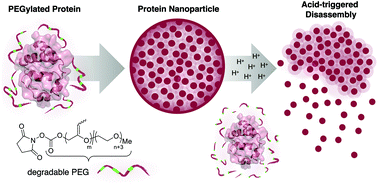
Polym. Chem., 2020,11, 551-559
https://doi.org/10.1039/C9PY01162E
Diblock brush-arm star copolymers via a core-first/graft-from approach using γ-cyclodextrin and ROMP: a modular platform for drug delivery
Water-soluble diblock brush-arm star copolymers using γ-CD-based core-first ring-opening metathesis polymerization, allowing for anticancer drug delivery via host–guest interaction.
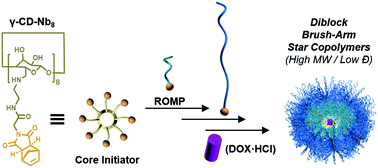
Polym. Chem., 2020,11, 541-550
https://doi.org/10.1039/C9PY01146C
A bio-orthogonal functionalization strategy for site-specific coupling of antibodies on vesicle surfaces after self-assembly
Attaching targeting ligands on the surface of self-assembled drug delivery systems is one of the key requests for a controlled transport of the drug to a desired location.
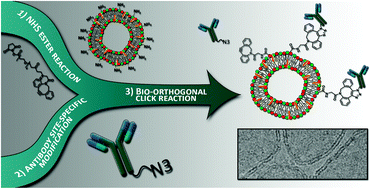
Polym. Chem., 2020,11, 527-540
https://doi.org/10.1039/C9PY01136F
Repurposing poly(monothiocarbonate)s to poly(thioether)s with organic bases
This work reports a unique one-pot/one-step route to rapidly produce poly(thioether)s from poly(monothiocarbonate) (PMTC), a sulfur-containing polymer, using commercially available organic bases.

Polym. Chem., 2020,11, 309-314
https://doi.org/10.1039/C9PY01147A
Synthetic route-dependent intramolecular segregation in heteroarm core cross-linked star polymers as Janus-like nanoobjects
Polymerization-induced intramolecular segregation can be realized during the “in–out” synthesis of heteroarm core cross-linked star polymers to facilitate well-defined microphase separation.
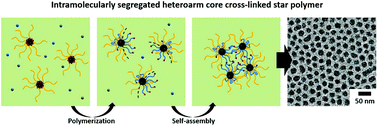
Polym. Chem., 2020,11, 449-460
https://doi.org/10.1039/C9PY00947G
New versatile bimolecular photoinitiating systems based on amino-m-terphenyl derivatives for cationic, free-radical and thiol–ene photopolymerization under low intensity UV-A and visible light sources
The performance of a series of 2-amino-4,6-diphenyl-benzene-1,3-dicarbonitrile derivatives as visible light sensitizers for diphenyliodonium salt for enabling photopolymerization at different irradiation wavelengths was studied.
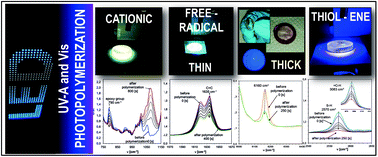
Polym. Chem., 2020,11, 480-495
https://doi.org/10.1039/C9PY01091B
The effect of side-chain branch position on the thermal properties of poly(3-alkylthiophenes)
Branching closer to the backbone causes tighter packing in the side-chain direction and lower side chain and backbone dynamics.

Polym. Chem., 2020,11, 517-526
https://doi.org/10.1039/C9PY01026B
Synthesis and characterization of a semiconducting and solution-processable ruthenium-based polymetallayne
Semiconducting, redox-active and solution-processable: accessing a highly functional Ru–polymetallayne via copper-free dehydrohalogenation polymerization.

Polym. Chem., 2020,11, 472-479
https://doi.org/10.1039/C9PY01090D
Non-solvating, side-chain polymer electrolytes as lithium single-ion conductors: synthesis and ion transport characterization
Non-solvating, side-chain polymer electrolytes with more dissociable pendent anion chemistries exhibit a dielectric relaxation dominated lithium ion transport mechanism.
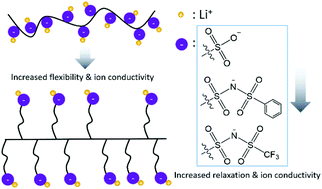
Polym. Chem., 2020,11, 461-471
https://doi.org/10.1039/C9PY01035A
Synthesis of modifiable photo-responsive polypeptides bearing allyloxyazobenzene side-chains
A photo-responsive and modifiable polypeptide with stable helical conformation was synthesized. The self-assembly and liquid crystalline phase structure were subsequently studied.
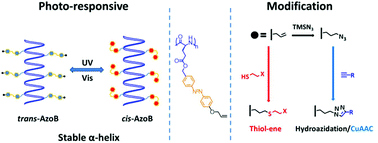
Polym. Chem., 2020,11, 439-448
https://doi.org/10.1039/C9PY01106D
Cellulose nanocrystal-reinforced poly(5-triethoxysilyl-2-norbornene) composites
We demonstrate the reinforcement of a previously inaccessible norbornene-silane with a stiff, bio-based nanofiller.
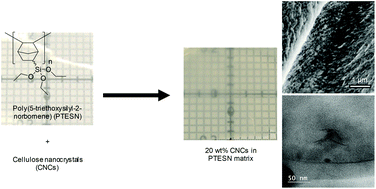
Polym. Chem., 2020,11, 433-438
https://doi.org/10.1039/C9PY00963A
Real time monitoring of peptide delivery in vitro using high payload pH responsive nanogels
A pH responsive pMAA nanogel that demonstrates high loading capacity and rapid intracellular delivery of hydrophilic peptides.
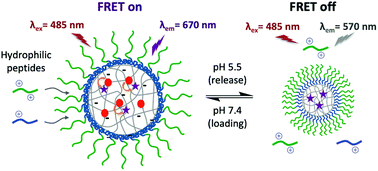
Polym. Chem., 2020,11, 425-432
https://doi.org/10.1039/C9PY01120J
Ligand–metal secondary interactions in phosphine–sulfonate palladium and nickel catalyzed ethylene (co)polymerization
Ligand secondary interactions and Lewis acid modulation are simultaneously achieved in palladium and nickel catalyzed ethylene polymerization and copolymerization.
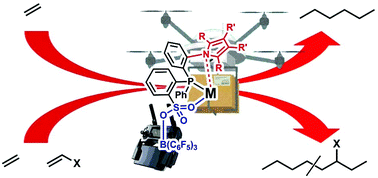
Polym. Chem., 2020,11, 411-416
https://doi.org/10.1039/C9PY00904C
“One-pot” aminolysis/thia-Michael addition preparation of well-defined amphiphilic PVDF-b-PEG-b-PVDF triblock copolymers: self-assembly behaviour in mixed solvents
Novel amphiphilic PVDF-based triblock copolymer (PVDF50-b-PEG136-b-PVDF50) is synthesized using RAFT polymerization and a one-pot thia-Michael addition. Self-assembly of this ABA copolymer resulted in formation of original crystalline structures.
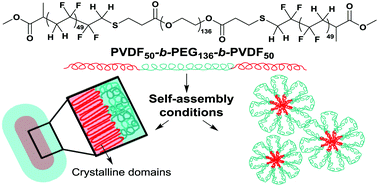
Polym. Chem., 2020,11, 401-410
https://doi.org/10.1039/C9PY00970A
Rapid synthesis of PEGylated multiblock polymers by sequence-controlled polymerization in H2O
Multiblock polymers with a poly(ethylene glycol) (PEG) block are attractive candidates for biomedical applications because of their favorable properties regarding biocompatibility and hydrophilicity.
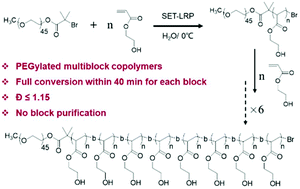
Polym. Chem., 2020,11, 417-424
https://doi.org/10.1039/C9PY01202H
Impact of metal cations on the thermal, mechanical, and rheological properties of telechelic sulfonated polyetherimides
The glass transition temperature, thermal degradation temperature, and complex viscosity of metal sulfonated polyetherimides decrease with an increase in metal cation size.
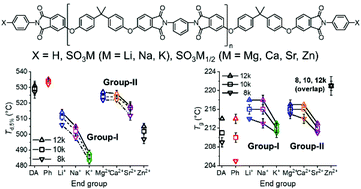
Polym. Chem., 2020,11, 393-400
https://doi.org/10.1039/C9PY00899C
A pH-responsive graftable supramolecular polymer with tailorable surface functionality by orthogonal halogen bonding and hydrogen bonding
Orthogonal halogen (X)-bonding and hydrogen (H)-bonding have been employed for constructing a surface functionalizable supramolecular polymer in water featuring tunable morphology and dual stimuli (pH and temperature) responsive properties.
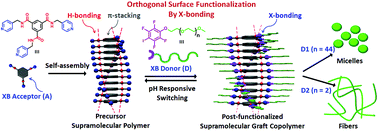
Polym. Chem., 2020,11, 385-392
https://doi.org/10.1039/C9PY00944B
Influence of block sequence on the colloidal self-assembly of poly(norbornene)-block-poly(ethylene oxide) amphiphilic block polymers using rapid injection processing
A facile self-assembly method, rapid injection, was used to study the self-assembly difference between AB diblock and ABA triblock copolymers.
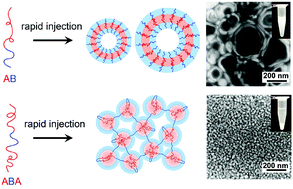
Polym. Chem., 2020,11, 375-384
https://doi.org/10.1039/C9PY00954J
Engineering orthogonality in the construction of an alternating rhomboidal copolymer with high fidelity via integrative self-sorting
An alternating rhomboidal copolymer was prepared through the combination of orthogonal self-assembly between metal-coordination and host-guest chemistry as well as integrative self-sorting strategy associated with molecular size and steric effect.
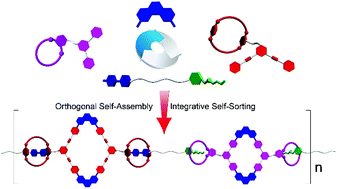
Polym. Chem., 2020,11, 367-374
https://doi.org/10.1039/C9PY00848A
Fractography of poly(N-isopropylacrylamide) hydrogel networks crosslinked with mechanofluorophores using confocal laser scanning microscopy
Employing mechanofluorophores in polymer fractography to obtain new information on force-induced events when analyzed by confocal laser scanning microscopy.
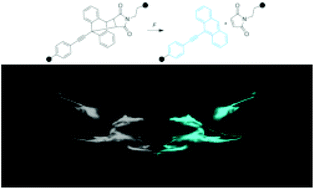
Polym. Chem., 2020,11, 358-366
https://doi.org/10.1039/C9PY00819E
Star polymers with acid-labile diacetal-based cores synthesized by aqueous RAFT polymerization for intracellular DNA delivery
Facile low temperature aqueous heterogeneous RAFT polymerization for preparation of novel star polymers with acid-labile diacetal-based cores for DNA delivery.
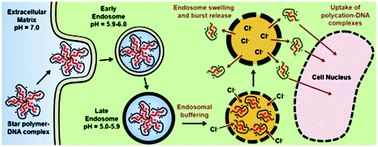
Polym. Chem., 2020,11, 344-357
https://doi.org/10.1039/C9PY00573K
Predictive design of polymer molecular weight distributions in anionic polymerization
Polymer molecular weight distributions are targeted through kinetic modeled with high fidelity based on the temporal control of chain initiation in anionic polymerizations.
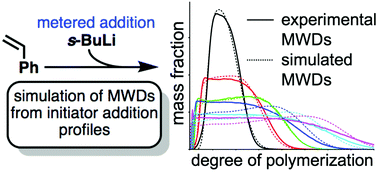
Polym. Chem., 2020,11, 326-336
https://doi.org/10.1039/C9PY00074G
Model-based design and synthesis of ferrocene containing microgels
Modelling and synthesis go hand in hand to efficiently engineer copolymer microgels with various architectures: core–shell structures (with ferrocene mainly in the core or in the shell) and also microgels with homogeneous comonomer distribution.
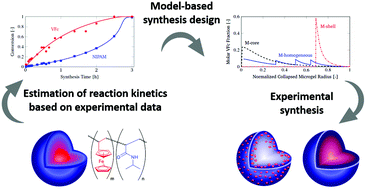
Polym. Chem., 2020,11, 315-325
https://doi.org/10.1039/C9PY00494G
Self-crosslinking assemblies with tunable nanostructures from photoresponsive polypeptoid-based block copolymers
A series of reversible crosslinking assemblies with tunable morphologies are obtained from a new family of photoresponsive polypeptoid-based diblock copolymers.

Polym. Chem., 2020,11, 337-343
https://doi.org/10.1039/C9PY00385A
About this collection
Polymer Chemistry is proud to present this 2020 Emerging Investigators collection. This collection gathers the very best work from polymer scientists in the early stages of their independent careers. The 2020 Polymer Chemistry Emerging Investigators were individually nominated by members of the journal Editorial and Advisory Boards, and previous Emerging Investigators, in recognition of their potential to influence future directions in the field.
Accompanying this collection is the Emerging Investigators special issue, in which these articles will be formally published. This issue is scheduled for publication in early 2020.